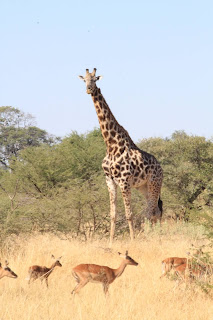It used to be called "The Dark Continent". Africa was a place of exotic animals inhabiting dense jungles and wide savannas, explorers in shorts and pith helmets, primitive native villages. Well, Africa is no longer "dark"; it has modern cities, friendly people, and best of all it still has jungles, savannas, and exotic animals. So, when Travel Leaders scheduled their annual International Summit in Cape Town, South Africa, I was eager to sign up.
Wednesday-Thursday, April 3-4, 2013
Minneapolis to Johannesburg, South Africa
The only downside to going to Africa is that it's a long trip. Our first leg was from Minneapolis to Atlanta, and then it was 15 hours to Johannesburg. I flew "economy comfort", and while it's not as luxurious as "business" or "first class", it offers more leg and reclining room, which is very important on a long flight. A major plus: it is about 10% of the cost of a first-class ticket!
My traveling companions were all good friends and colleagues with Travel Leaders: Denise Petricka from Eau Claire, Laurie Passard from Grand Rapids, Minn., and Kim Gorres from New Richmond. With the International Summit opening in Cape Town on April 12th, we decided to arrive in country early and take a safari. Our host was Grosvenor Tours, which handled all the arrangements. All we had to do was show up!
South African Standard Time is seven hours ahead of Central Daylight, so it was late Thursday afternoon when we touched down at O.R. Tambo International Airport in Johannesburg, the largest city not only in South Africa but in the entire continent south of the Sahara, with over seven million people in the metro area. We checked into our hotel, the Saxon, about 45 minutes from the airport. The Saxon is a destination in itself.
 |
| The reception area of the Saxon. It looked a lot more glamorous than we did, after 18 hours in the air. |
 |
| Our rooms were suites, with large bathrooms and private butlers. |
Friday, April 5 -- Johannesburg
There's a lot to see and do in Johannesburg, so after relaxing for part of the day and using the Saxon's terrific gym and pool, we set out for Mandela Square.
 |
| Mandela Square, with great dining and shopping. |
 |
| South Africa is known for its great wines, so we made sure to visit a local wine shop. |
Saturday, April 6 -- Sanctuary Stanley's Camp, Botswana
This morning we headed back to O.R. Tambo for a flight to Maun, Botswana. Tambo is a huge airport and here's a cautionary note: make sure you deal only with official airport personnel, wearing orange vests. We were greeted by an official-looking "representative", who wanted to be paid before he would give us back our bags.
Our flight to Botswana was two and a half hours. After clearing customs we boarded a small plane for the
short hop to Sanctuary Stanley's Camp. The plane was designed for six passengers with one small duffel bag per person. Needless to say, they weren't quite prepared for four American women and their luggage, but we managed.
 |
| Note the small pod near the wheel. That's for luggage. We almost needed an extra plane. |
 |
| Denise was the co-pilot, but we arrived safely anyway. |
 |
| We were greeted by Botswanese, dancing and singing. |
 |
| The main area of the camp. |
 |
| Our tent. Yes, we were roughing it. |
 |
| The African wart hog, familiar to us as Poombaa in The Lion King. |
 |
| The first of many giraffes we would see. |
 |
| Wildebeest herd on the move. |
 |
| In Africa they have a tradition called the "sundowner", where guests gather at sundown for drinks and snacks. This was a custom we all agreed was one we would adopt at home. |
Sunday, April 7 -- Botswana
After breakfast, we participated in the camp's feature attraction, interaction with elephants. The African elephant is the largest land animal on Earth. Males can grow to 13 feet tall at the shoulder and weigh upwards of six or seven tons. The elephants at Stanley's Camp are orphans that are semi-habituated, meaning they are used to interacting safely with humans---on their terms. We would meet them in their own environment. The three elephants we met were named Jabu, Thembi and Morula. Our hosts were Doug and Sandi Groves, the "adoptive parents" of the elephants. The interaction was one of the highlights of our entire trip, especially when they joined us for lunch!
 |
| Our new African bodyguard. |
 |
| Jabu, the big guy of the trio. |
 |
| Our host, Doug Graves, and the elephants join us for lunch. |
 |
| Kim and Denise with Jabu, who eats lunch wherever he wants. |
The game drive was a thrill, but we were anxious to head back to camp for dinner and another evening in the bush. The camps' menus are surprisingly extensive, with a good selection of entrees, including one vegetarian dish, with one of the two meat dishes featuring local cuisine, like the ostrich Denise enjoyed. The meals are always accompanied by great South African wines.
 |
| It was another rough day in camp, but we toughed it out. |
 |
| Another day in Africa comes to a close, with another sundowner. |









No comments:
Post a Comment